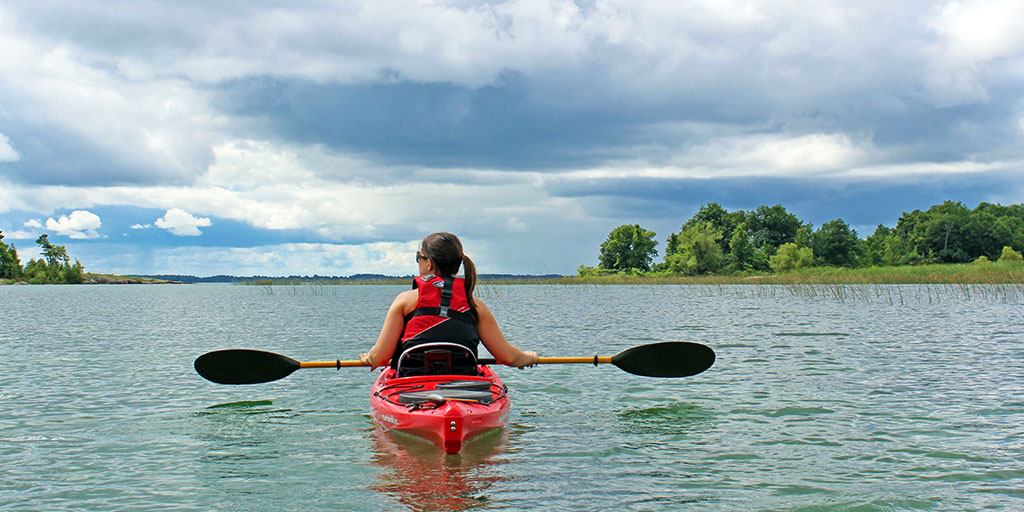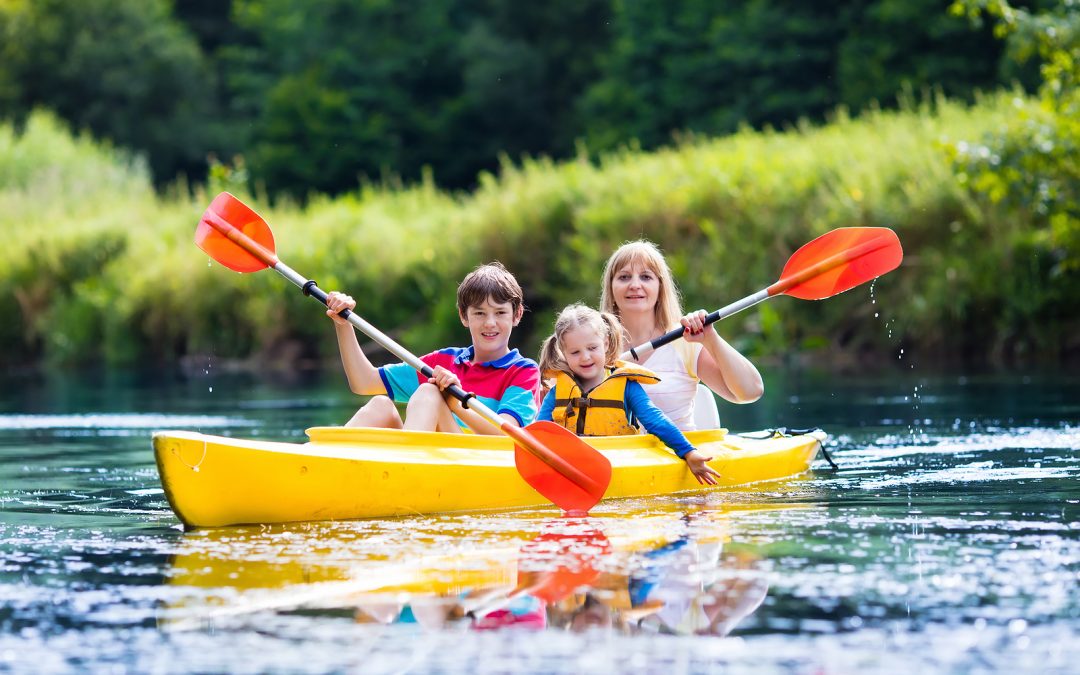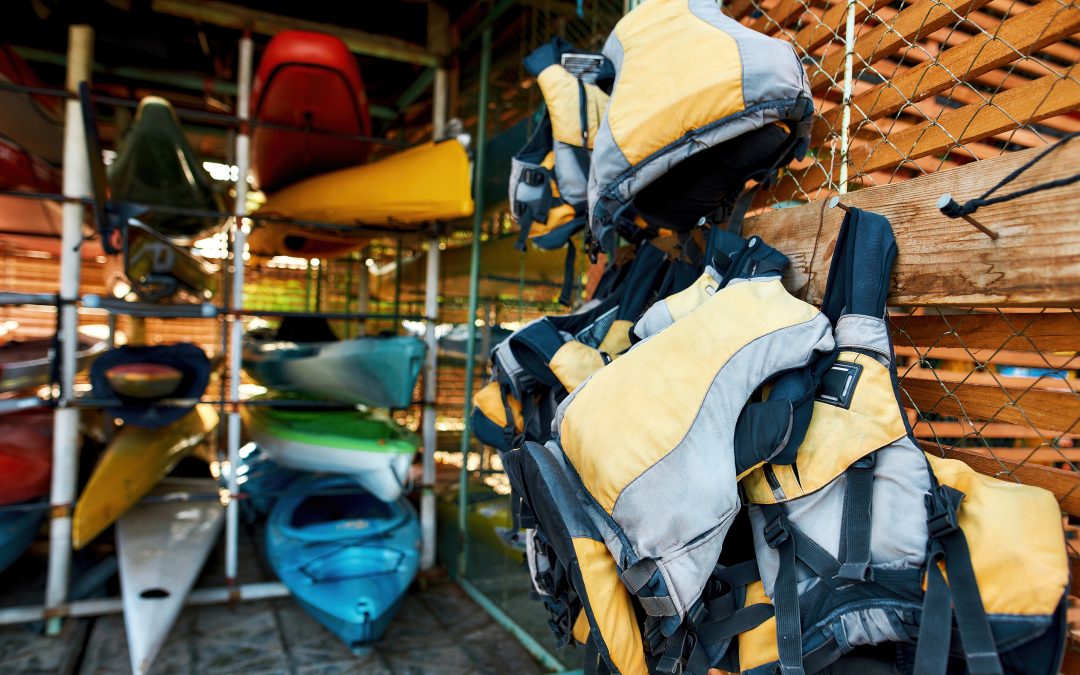High-intensity kayaking offers a unique and challenging way to enjoy the water and improve overall fitness. This approach involves short bursts of vigorous paddling followed by rest periods or low-intensity exercise, similar to high-intensity interval training (HIIT) in aerobic workouts. The goal is to increase endurance, cardiovascular strength, and overall fitness while experiencing the thrill of navigating rivers, lakes, and oceans.

To get started with high-intensity kayaking, it’s essential to understand what the sport entails and how to prepare for it. This includes learning the fundamentals of kayak paddling, acquiring the required gear and equipment, and developing a practical training plan to build endurance, strength, and speed. Additionally, mastering balance and coordination techniques and considering nutrition and safety measures will contribute to a successful and enjoyable high-intensity kayaking experience.
Key Takeaways
- High-intensity kayaking incorporates short, vigorous paddling intervals to improve endurance and overall fitness.
- Preparing for high-intensity kayaking involves learning fundamentals, obtaining gear, and creating a training plan.
- Mastering balance, coordination, and proper nutrition will enhance kayaking performance and enjoyment.
Understanding High-Intensity Kayaking
Defining High-Intensity Interval Training
High-intensity kayaking is a form of exercise that combines kayaking with the principles of high-intensity interval training (HIIT). HIIT is a popular workout method alternating between short bursts of intense activity and periods of rest or low-intensity exercise^[1]^.
In kayaking, high-intensity intervals can involve vigorous paddling, followed by rest periods or low-intensity paddling. This exercise challenges the paddler’s endurance, cardiovascular strength, and overall fitness1.
Benefits of Kayaking for Fitness
Kayaking is an excellent form of exercise, thanks to its full-body engagement and low-impact nature. The following list outlines some key fitness benefits of high-intensity kayaking:
- Cardiovascular health: High-intensity kayaking can improve your heart health, as the intervals of intense paddling increase your heart rate and strengthen your cardiovascular system2.
- Muscle strength and endurance: Kayaking is a full-body workout that engages your arms, shoulders, back, core, and legs3—the high-intensity intervals in this kayaking type help build muscle strength and endurance.
- Balance and coordination: Kayaking requires excellent balance and coordination to navigate and control the kayak. As a result, high-intensity kayaking can improve both balance and coordination skills.
- Weight loss and calorie burning: Due to the increased intensity, high-intensity kayaking can quickly burn calories and aid in weight loss while still being a fun and enjoyable form of exercise.
- Mental health benefits: Like other forms of exercise, high-intensity kayaking can positively impact mental health, reducing stress and anxiety levels and releasing endorphins for an overall mood boost as you immerse yourself in nature and enjoy the water4.
In conclusion, high-intensity kayaking is a challenging yet enjoyable option for those who love water sports and want to improve their fitness. Incorporating HIIT principles into this activity can increase endurance, strength, and cognitive benefits for a diverse and rewarding workout experience.
Footnotes
Preparing for High-Intensity Paddling
Assessing Your Fitness Level
Before diving into high-intensity kayaking, evaluating your current fitness level is essential. As a beginner, you should have a base level of physical activity and cardiovascular strength before engaging in this rigorous exercise. High-intensity kayaking involves short bursts of vigorous paddling followed by rest periods or low-intensity exercise, similar to high-intensity interval training (HIIT) in aerobic workouts.
To assess your fitness, consider the following factors:
- Aerobic Endurance: Your ability to perform prolonged physical activity without excessive fatigue.
- Strength: The capability of your muscles to produce force, particularly in your upper body, core, and legs.
- Flexibility: The range of motion around your joints affects your paddling technique and overall comfort.
If you have concerns about your fitness level, consult a professional trainer or healthcare provider before engaging in high-intensity kayaking.
Setting Realistic Goals
As a beginner, setting achievable short-term and long-term goals to track your progress and stay motivated is crucial. Start by establishing a solid foundation in the basics of kayaking, such as paddling techniques, safety measures, and equipment handling. Then, gradually incorporate high-intensity workouts, increasing the intensity and duration.
Here are some suggested goals for high-intensity kayaking:
- Improve cardiovascular endurance: Three times a week, aim for at least 30 minutes of continuous aerobic activity, such as brisk walking or light jogging. Increase the duration and intensity as you become more comfortable.
- Increase upper-body strength: Incorporate exercises like push-ups, pull-ups, and resistance band training into your routine to enhance the muscles used during paddling.
- Develop core stability: Engage in exercises like planks, Russian twists, and kettlebell swings to build strength and stability for efficient paddling.
Remember to be patient with your progress; high-intensity kayaking can be challenging for beginners. Continually reassess your goals and adjust your training plan to ensure a safe, enjoyable, and rewarding experience on the water.
Essential Gear and Equipment
Choosing the Right Kayak
Selecting the appropriate kayak for high-intensity kayaking is crucial. Beginners might find a sit-on-top kayak the best option, as they are generally more affordable and user-friendly. Various kayak designs and materials are available, each catering to specific uses, so it is vital to choose one suited for high-intensity paddling.
Key Paddling Accessories
Paddle: Regarding high-intensity kayaking, a double-bladed paddle is a common choice, providing more power, control, and efficiency in every stroke. Ensure the paddle is the correct length for your kayak and personal preference.
Safety Gear: A life jacket is the most crucial safety gear, as it can save your life in an emergency. Most kayak rental companies provide life jackets for free with the rental. Other essential safety items include a whistle and a headlamp.
Clothing: For warm-weather outings, wear non-cotton, non-binding swimwear or shorts, a short or long-sleeve rashguard top, neoprene footwear, a sun-shielding hat, and a lightweight fleece jacket or vest, depending on the weather conditions. REI offers a helpful guide to proper kayaking attire.
Load: It is essential to secure and evenly distribute the load on your kayak to maintain balance and stability. High-intensity kayaking requires agility and quick maneuvering, so avoid overloading your kayak with unnecessary items.
Additional Accessories: Some helpful accessories to consider include a bilge pump (applicable in case of water entry), a paddle leash to keep track of your paddle, and a dry bag to store personal belongings safely.
Fundamentals of Kayak Paddling
Paddling Techniques
High-intensity kayaking requires mastering essential paddling techniques to improve endurance, cardiovascular strength, and overall fitness. Like other water sports, kayaking employs several paddling techniques depending on speed and maneuverability.
The essential paddling methods are the forward stroke and the sweep stroke. The forward stroke is the primary technique for moving the kayak in a straight line, while the sweep stroke aids in turning the kayak. To perform the forward stroke:
- Hold the paddle with both hands, keeping them shoulder-width apart.
- Dip one side of the paddle blade into the water, positioned close to the kayak’s hull.
- Utilize your torso and core muscles to pull the blade towards the rear of the kayak.
- Lift the paddle out of the water and repeat on the other side.
For the sweep stroke, extend the paddle outwards and trace a wide arc in the water, pulling the blade towards the opposite side of the kayak.
Maintaining Proper Form
Maintaining proper form is essential for maximizing the efficiency of your paddling techniques. Engage your core muscles to generate power and maintain balance as you paddle. Sit straight and avoid hunching your back, ensuring your upper body rotates during each stroke.
Pay attention to your hand placement on the paddle. Your hands should be shoulder-width apart, with your elbows bent comfortably. Remember to grip the paddle firmly but not too tightly, as this may lead to fatigue and strain on your wrists and hands.
In conclusion, learning and mastering the fundamental paddle techniques, maintaining proper form, and engaging your core muscles are crucial in high-intensity kayaking. Building a solid foundation in these areas will help you excel in this sport and experience its benefits.
Developing a High-Intensity Training Plan
Structuring Your Workout
When it comes to high-intensity kayaking, establishing an effective workout structure is essential. Start by incorporating a proper warm-up, main exercise, and cool-down into your routine.
- Warm-up: To increase blood flow, warm up for 5-10 minutes with light cardio activities, such as jogging or jumping rope. Finish with dynamic stretching exercises to improve your flexibility and kayak-specific movements.
- Main Exercise: The main exercise should consist of high-intensity kayaking intervals. One example is 30 seconds of all-out paddling followed by 1-2 minutes of active rest. Repeat this pattern for 20-30 minutes to maintain proper form and technique.
- Cool-down: Conclude your workout with a 5-10 minute cool-down. Focus on low-intensity exercises like slow paddling or gentle stretching to help your body recover.
Including Cross-Training Activities
In addition to high-intensity kayaking workouts, it’s essential to include cross-training activities in your training plan. These exercises will develop your overall fitness and help prevent potential injuries. Consider the following activities:
- Strength Training: Focus on workouts that target your core, upper body, and lower body muscles. Weightlifting, bodyweight exercises, or resistance band activities can all be helpful. For instance, use high-intensity resistance training to boost your lumbar spine bone mineral density.
- Cardiovascular Training: Opt for non-kayaking exercises that increase your cardiovascular strength. Running, cycling, or swimming are examples of activities that can achieve this goal. Aim for 30-60 minutes of moderate-intensity cardio at least thrice weekly.
- Flexibility Training: Maintain your flexibility and range of motion with regular stretching. Yoga or pilates are excellent options. Prioritize muscle groups engaged during kayaking, such as your shoulders, hips, and hamstrings.
By crafting a well-rounded, high-intensity training plan with kayaking workouts and cross-training activities, you can effectively improve your strength, stamina, and overall performance on the water.
Building Endurance and Stamina
Continuous vs. Interval Training
When it comes to high-intensity kayaking, building endurance and stamina is essential for optimal performance. Two primary training methods for developing these qualities are continuous training and interval training.
Continuous training involves performing an activity, such as kayaking, at a steady pace for an extended period. This method helps improve cardiovascular fitness and muscular endurance. On the other hand, interval training consists of alternating between high-intensity and low-intensity activity. This allows the body to adapt to higher intensity levels, improving its capacity to power up a workout.
| Training Method | Key Features | Benefits |
|---|---|---|
| Continuous | Steady pace, extended duration | Cardiovascular fitness, endurance |
| Interval | Alternating high- and low-intensity | Increased stamina |
Progressive Overload Principle
Following the progressive overload principle is essential to build endurance and stamina consistently. This principle involves gradually increasing the demands on the body during exercise. By doing so, the body adapts to the new demands, increasing fitness levels.
For instance, when focusing on continuous training, increase the duration of your kayaking sessions by 5-10 minutes each week. This gradual increase helps improve muscular endurance and cardiovascular fitness.
For interval training, consider adjusting the intensity and duration of the high-intensity bouts or shortening the rest periods. It’s crucial to pay attention to your body and make adjustments based on how you feel. Ensuring you have adequate recovery and stress management is essential for optimal performance.
In summary, utilizing continuous and interval training methods and the progressive overload principle is the key to building endurance and stamina for high-intensity kayaking. Remember to listen to your body, adjust the intensity as needed, and ensure a proper recovery to maximize your performance.
Strength and Resistance Training

Targeting Core Muscle Groups
High-intensity kayaking requires a solid core to maintain stability and paddle efficiently. Targeting the critical muscle groups involved is crucial to improve your performance in this sport. The most important muscles to focus on include the lats, trapezius, rhomboids, deltoids, and biceps1. A balanced workout routine should include exercises that activate and strengthen these areas.
To enhance stability, include core-strengthening exercises like planks, Russian twists, and bird dogs. These exercises work your abdominal muscles and target the obliques and lower back muscles, equally crucial for kayaking performance2.
Incorporating Weight Training
Weight training can be highly beneficial for high-intensity kayaking, as it helps to build muscle endurance and power. Incorporating a structured weight training program can significantly improve your paddling skills, stability, and overall fitness3.
Some practical strength training exercises for kayakers include:
- Single Arm Bent Over Row 4: This exercise targets the lats, upper back, shoulders, and biceps. It can help enhance the pulling movement of a kayaking paddle stroke.
- Pull-Ups5: This compound exercise focuses on the back and biceps muscles and aids in developing upper-body strength.
- Seated Row 6: This exercise targets the lats and other supporting back muscles critical for paddling power.
- Push-Ups: This fundamental exercise targets the chest, triceps, and shoulders, essential for efficient paddling.
Prioritizing proper form and technique when performing weight training exercises is crucial, as this will help prevent injuries and enhance your results. Resistance and strength training are vital components of a well-rounded, high-intensity kayaking fitness plan that will leave you feeling confident and prepared out on the water.
Footnotes
- https://hartadventureracing.com/strength-training-for-kayaking/ ↩
- https://www.rei.com/learn/expert-advice/how-to-train-for-kayaking.html ↩
- https://paddlingmag.com/gear/accessories/fitness-training/strength-training-for-kayaking/ ↩
- https://hartadventureracing.com/strength-training-for-kayaking/ ↩
- https://blog.torokhtiy.com/guides/strength-training-for-kayaking/ ↩
- https://blog.torokhtiy.com/guides/strength-training-for-kayaking/ ↩
Techniques for Maximizing Power and Speed

The Role of Anaerobic Capacity
Anaerobic capacity is vital in maximizing power and speed in high-intensity kayaking. It refers to the ability of the muscles to produce energy without using oxygen, allowing kayakers to perform short, intense bursts of effort. In sprint kayak events, this capacity is crucial for achieving high-speed performance and maintaining it during the race. To improve their anaerobic capacity, kayakers can engage in targeted exercises focusing on the upper body, particularly the muscles required for powerful paddling strokes.
Sprint Training Exercises
Sprint training exercises can help kayakers increase power and speed through various drills. Here are some practical exercises to incorporate into your training routine:
- Interval Training: Alternating between high-intensity paddling and short rest periods allows kayakers to improve their cardiovascular fitness and muscle endurance. This type of training closely mimics the conditions of sprint kayak races, helping the athletes to adapt their bodies and techniques accordingly [1].
- Resistance Training: By incorporating resistance bands or weights into their workouts, kayakers can build power and strength in their upper body, core, and legs. Typical exercises include bench presses, pull-ups, and rows for the upper body, squats and lunges for the legs, and Russian twists for the core.
- Plyometrics: Plyometric exercises involve explosive movements designed to increase power and speed. Examples include explosive and clapping push-ups, which help kayakers develop a more efficient and powerful paddle stroke.
When combined with a structured training plan and proper technique, these exercises can significantly improve power, speed, and overall performance in high-intensity kayaking. Always consult a coach or experienced kayaker to ensure an appropriate form and execution of these drills.
Mastering Balance and Coordination

Stability Drills on Water
One of the crucial aspects of high-intensity kayaking is maintaining balance while performing vigorous paddling. Several stability drills on water can help improve a paddler’s balance and coordination. First, try side-to-side rocking of the kayak, which will help you understand the kayak’s stability limits. Next, practice edging, leaning the kayak on one edge while maintaining an upright body posture. This exercise will improve balance and make you more familiar with the kayak’s response to body movements1.
In addition, bracing drills can enhance your ability to recover balance after sudden weight shifts. A low brace involves extending your arms and using your paddle’s back face to push against the water, preventing a capsize. Conversely, a high brace uses the paddle’s power face to perform a similar action but with your arms in a more vertical position2. These exercises will improve your balance and coordination on the water, making you better prepared for high-intensity kayaking.
Cross-Training for Better Balance
Cross-training can significantly improve your balance and coordination, which is essential for high-intensity kayaking. Incorporating exercises that target core muscles and the lower body will provide a strong foundation for maintaining stability during vigorous paddling3. Some examples include:
- Yoga and Pilates: These practices emphasize body awareness, flexibility, and balance, all of which help produce a stable base for kayaking. They also strengthen core muscles, which is essential for efficient paddling and maintaining proper posture in the kayak4.
- Balance Board Exercises: Using a balance board can challenge your stabilizer muscles and improve your core strength. Try standing on the board while performing squats, lunges, or even simulating kayak paddling. This type of workout will directly translate to better balance and coordination in your kayak.
- Cycling and Running: These activities enhance lower-body strength and aerobic endurance, making them valuable to your cross-training routine. Building a solid fitness foundation will improve stability and balance when transitioning to high-intensity kayaking5.
In summary, mastering balance and coordination in high-intensity kayaking involves practicing stability drills on water and incorporating various cross-training exercises that target core strength, flexibility, and lower-body fitness. By dedicating time to these activities, you are setting yourself up for success as you embark on your high-intensity kayaking journey.
Footnotes
Nutrition and Diet for Kayaking Athletes

Optimizing Energy Intake
A well-planned diet is essential for high-intensity kayaking as it ensures athletes have the energy needed for their demanding training sessions. To optimize energy intake, kayakers must consume a balanced diet containing carbohydrates, proteins, and fats, as sports dietitians recommend. Carbohydrates should be the primary energy source, fueling aerobic and anaerobic activity. The following list highlights some key food sources for each macronutrient:
- Carbohydrates: Whole grains, fruits, vegetables, rice, and pasta.
- Protein: Lean meats, poultry, fish, eggs, tofu, legumes, and dairy products.
- Fats: Avocado, nuts, seeds, and olive oil.
It is also advised that athletes eat frequently every 2-4 hours to maintain their energy levels throughout the day and support muscle recovery.
Hydration Strategies
Proper hydration is vital for high-intensity kayaking, especially during intense training sessions or hot, sunny days. Dehydration can impair an athlete’s performance and increase the risk of injury. It is recommended that kayakers consume at least 3 liters of water per day to stay properly hydrated.
To help monitor hydration levels, athletes can pay attention to the color of their urine. A pale straw color indicates adequate hydration, while darker yellow or amber-colored urine can signal that more water is needed. Consuming electrolyte-containing sports drinks can be beneficial during longer training sessions or competitions to replenish lost electrolytes through sweating.
In summary, a well-balanced diet, frequent meals, and proper hydration are critical for high-intensity kayaking athletes to optimize their performance and overall health. Providing their body with the right nutrients and hydration will help kayakers handle the demands of their training and competitions.
Injury Prevention and Safety Measures

Protecting Joints and Muscles
When participating in high-intensity kayaking, protecting your joints and muscles from potential injuries is essential. Start by warming up before engaging in any vigorous exercise. This helps prepare your body and minimize the risk of injury. Incorporate dynamic stretches targeting the upper and lower body, stimulating blood flow and increasing flexibility.
Another critical aspect is proper paddling technique. Maintain a neutral spine position throughout the activity to reduce stress on the lower back. When paddling, engage your core muscles and rotate from the hips rather than straining your arms or shoulders.
To further protect your joints, consider using a lightweight paddle and ensure it is the appropriate length for your height. This proper equipment choice reduces the stress on your muscles and joints, allowing for a more enjoyable experience.
Safety Protocols on Water
Navigating the water safely is crucial to prevent accidents and injuries while kayaking. The following are some essential safety protocols to follow:
- Wear a Personal Flotation Device (PFD): A PFD is essential for beginners and experienced kayakers. If you capsize, a PFD can keep you afloat and prevent drowning.
- Check Weather and Water Conditions: Before starting, always check the weather forecast and know the area’s potential hazards, such as currents, tides, and obstacles.
- Use the Buddy System: Kayaking with others ensures you have someone to help you if an accident or injury occurs. It’s always safer to have someone nearby who can assist.
- Follow Local Rules and Regulations: Familiarize yourself with the rules and regulations specific to the area where you will be kayaking. These can include designated routes, speed limits, and prohibited zones.
Kayaking is an exciting and intense water sport, and following injury prevention practices and safety protocols can ensure you enjoy the experience while staying safe and healthy.
Tracking Progress and Performance

Assessing Improvements
Assessing improvements in high-intensity kayaking involves monitoring both physical fitness and technical skills. Set specific, measurable, achievable, relevant, and time-bound (SMART) goals to track your progress effectively. For example, work on increasing paddle stroke speed or improving body posture to maintain a more efficient kayak positioning.
One way to measure progress is by maintaining a training log. Document your training sessions, including distance, time, and exercise types. Over time, this allows you to identify trends and improvements in your overall performance. Additionally, self-assessment can be valuable. Periodically evaluate your skills, such as your ability to execute different paddle strokes and maintain a good body posture, as mentioned in this guide to improving kayak tracking.
Using Technology for Analytics
Technology has dramatically enhanced the ability to track and analyze performance in various sports, including high-intensity kayaking. Several helpful tools and devices can support your progress tracking:
- GPS Devices: Portable GPS devices or smartwatches with GPS capabilities help monitor distance, speed, and location. This data can reveal improvements in your navigation skills and overall performance.
- Heart Rate Monitors: Monitoring your heart rate during training sessions can provide insight into your cardiovascular fitness improvements and help identify optimal training intensities.
- Fitness Apps: Numerous fitness applications offer kayaking-specific features for tracking distance, speed, stroke rate, and even analyzing your stroke technique.
Leveraging technology can help you stay informed about your progress, allowing you to make data-driven adjustments to your training and achieve better performance in high-intensity kayaking. Remember to combine these technological tools with self-assessment and a thorough training log to understand your improvements comprehensively.
Environmental Factors Affecting Paddling

Dealing with Wind and Weather
When planning a high-intensity kayaking session, it is crucial to consider the environmental factors that could impact your performance. One of the main factors to be aware of is the wind and weather conditions.
Wind can significantly affect paddling speed, course, and stability. For instance, a strong headwind makes it more challenging to move forward, while a tailwind can push you to go faster than intended. Crosswinds might make it challenging to maintain a straight course. Check the weather forecast before heading out on the water, and adjust your plans accordingly if any strong winds are predicted.
Weather conditions like temperature, rain, and humidity can also influence your paddling experience. Prepare yourself and your gear properly to face whatever Mother Nature throws.
- Clothing: Dress in moisture-wicking and quick-drying fabrics, such as synthetic or merino wool materials. Layer your clothing so you can easily add or remove layers as needed.
- Nutrition: Stay well-hydrated and pack enough food to maintain your energy levels during longer paddling sessions.
- Safety Gear: Always wear a personal flotation device and bring safety essentials such as a whistle, a paddle float, and a bilge pump.
Adapting to Different Types of Water
In addition to wind and weather, the type of water you’re paddling on can significantly impact your high-intensity kayaking experience. There are three primary water types to be aware of:
- Flatwater: This includes calm lakes, ponds, and slow-moving rivers. Flatwater is the most beginner-friendly environment for high-intensity kayaking, offering stable conditions and predictable elements.
- Moving Water: Includes faster-flowing rivers with mild to moderate currents, estuaries, and tidal channels. This type of water requires more experience and skill, as you must contend with river features, eddies, and tide shifts.
- Whitewater: Ranging in difficulty level from Class I to Class VI rapids, whitewater kayaking can provide a challenging workout for even the most experienced paddlers. High-intensity kayaking on whitewater demands strong paddling skills, excellent balance, and quick decision-making abilities.
No matter which type of water you paddle on, always be conscious of environmental impact and strive to minimize your footprint. This includes choosing suitable launch and landing sites, avoiding damaging the shoreline, and respecting the wildlife in the area.
Psychological Aspects of Competitive Paddling
Cultivating a High-Performance Mindset
In high-intensity kayaking, developing a solid psychological foundation is essential for success. A high-performance mindset helps participants face various challenges and competition. Engaging in positive self-talk, setting realistic goals, and maintaining focus during training and races is essential to cultivate this mindset. For example, athletes can create a list of short-term and long-term goals, helping them stay on track and motivated throughout their journey.
Incorporating visualization techniques can also contribute to a more robust mental foundation. Athletes can imagine themselves executing perfect strokes, maintaining balance during challenging maneuvers, and pushing through fatigue. This mental practice can help improve actual performance and bolster their self-confidence.
Stress Management and Recovery
Competitive paddling can be both physically and mentally demanding. As a result, stress management and recovery are vital aspects of a successful high-intensity kayaking regimen. Deep breathing exercises, progressive muscle relaxation, and meditation can help athletes manage stress and maintain mental clarity during pressure-filled situations. Ensuring adequate rest and recovery, especially after intense training sessions, is crucial for preventing burnout and maintaining optimal performance.
Another effective technique to manage stress and promote recovery is social support. Athletes can benefit from connecting with like-minded people with a passion for high-intensity kayaking. This can be done through local paddling clubs or online communities. Sharing experiences, exchanging tips, and encouraging one another can provide a positive environment for growth and progress in the sport.
In conclusion, the psychological aspects of competitive paddling play a significant role in an athlete’s success. By cultivating a high-performance mindset, engaging in stress management techniques, and prioritizing recovery, high-intensity kayaking participants can enhance their mental resilience and excel in the competitive arena while enjoying their kayaking journey.
Frequently Asked Questions
What are the essential strength exercises to prepare for high-intensity kayaking?
To prepare for high-intensity kayaking, focusing on exercises that target the upper body, core, and lower body is essential. Some critical exercises include push-ups, pull-ups, seated rows, tricep dips, plank holds, and squats. By strengthening these muscle groups, you’ll be better prepared for the demands of high-intensity kayaking.
What home exercises are recommended for kayaking conditioning?
For conditioning at home, focus on bodyweight exercises such as push-ups, burpees, planks, side planks, and mountain climbers. Additionally, consider incorporating resistance bands for seated rows, chest presses, and bicep curls. Balance exercises, such as single-leg squats or lunges, can also help improve stability and coordination on the water.
Can you suggest a K1 kayak training program for beginners?
A good beginner K1 kayak training program should focus on building a solid fitness foundation and enhancing paddling skills. Aim for a mix of cardio activities (e.g., brisk walking, jogging, or swimming), resistance training for strength development, and specific paddling drills. Start by learning and practicing proper paddling techniques in flat water before progressing to more challenging environments. REI Expert Advice offers valuable guidance on kayak training exercises.
What are the health benefits associated with high-intensity kayaking?
High-intensity kayaking offers numerous health benefits, including improved cardiovascular endurance, muscle strength, core stability, and flexibility. It’s also a low-impact exercise that can help reduce joint strain and risk of injury. Additionally, the outdoor environment and varying intensities provide unique mental wellness benefits, such as reduced stress and improved mood.
How can one improve the technique for entering and exiting a kayak?
Improving your technique for entering and exiting a kayak starts with proper positioning and body awareness. Always approach the kayak parallel to the shoreline while maintaining a low center of gravity. Use the paddle for balance, keeping one hand on the coaming (cockpit rim) and the other on the paddle shaft. Practice entering and exiting your kayak in calm, shallow waters to build confidence and improve your technique.
Is upper body strength crucial for excelling in high-intensity kayaking?
While upper body strength is essential for high-intensity kayaking, it’s equally crucial to maintain a strong core and lower body. A balanced training program focusing on overall physical fitness will help ensure you have the strength, endurance, and stability needed to excel in high-intensity kayaking. Remember, proper technique and efficient paddling are as important as physical strength in this challenging sport.
Conclusion
High-intensity kayaking is an excellent water sport for those seeking a challenging and rewarding workout. To get started, it is crucial to follow these basic steps:
- Build Endurance and Strength: Improve cardiovascular health by participating in aerobic exercises such as running or swimming. Strengthen your core, arms, and back muscles through resistance training.
- Learn Proper Technique: Master paddling skills and body positioning through kayaking lessons or workshops, ensuring an efficient and safe experience on the water.
- Choose the Right Equipment: Select a suitable kayak and paddle for your fitness level and desired intensity. Invest in essential safety gear like a life jacket, helmet, and whistle.
- Gradually Increase the Challenge: Start with shorter, less intense sessions and progressively increase the difficulty to avoid injury or burnout. Incorporate interval training and balance exercises into your routine.
Remember, safety should always be a priority. Follow guidelines and local regulations while kayaking, and never venture into extreme conditions without proper preparation. By combining patience, practice, and diligent training, you will be well on your way to mastering high-intensity kayaking and reaping this thrilling water sport’s numerous physical and mental benefits.











